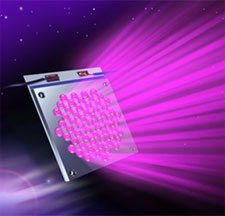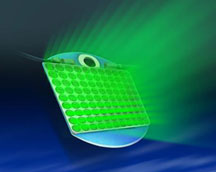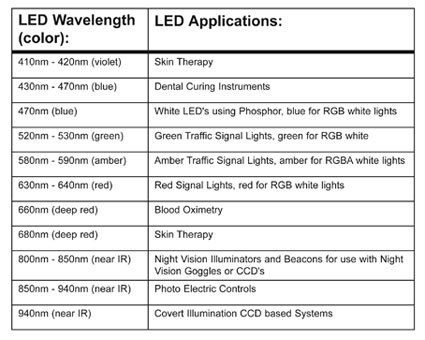Russ Dahl, Opto Diode Corporation
In applications where LEDs are being viewed directly, or being used as illuminators, exact color is far more important than exact output in lumens or candela.
The human eye is relatively insensitive to light intensity changes and the brain compensates quite well for what intensity changes occur. For example, looking at an LED video screen on a building, the average person will not notice an intensity drop of 20 percent as portions of the screen are viewed at 10 to 20 degrees off axis, as compared to the portion directly on axis. This is a gradual change moving toward the edge of your vision and it is not perceived. By the same token, if LEDs in one location are 10nm different in wavelength than one another, the viewer will easily see this color difference and find it distracting.

The 60-die LED. Photos courtesy of Opto Diode Corp.
The majority of white LEDs being used today are made from a blue LED pumping a yellow phosphor. Viewed directly, the LED will appear to be white as the blue and yellow wavelengths are mixed together in the package. This product is ideal for general outdoor lighting and indoor hallway lighting. However, for illumination where color rendering is important, (measured as a color-rendering index or CRI) this type of LED falls very short.
Color rendering is measured on a scale where 100 is a perfect match to sunlight across the visible spectrum. When the CRI falls below 80, viewing objects by eye will not result in seeing the true color. As a comparison, incandescent lights typically have a CRI above 80, while standard cool fluorescent lights have a CRI in the range of 60-65. This is why it is difficult to determine the true color of clothing in a store illuminated with fluorescent lights.
Color rendering is very important when reading topographical maps with an LED flashlight or when an electrician needs to discern wire colors with an LED flashlight. In museum illumination, a high color rendering index is vital to the perception of color in paintings and other works of art.
When poor color rendering is evident when illuminated by white LED’s, it is because the green and red components are weak. Sunlight has output at all visible wavelengths with relatively gradual and smooth transitions when graphed as power vs. wavelength; all colors can be determined equally well in sunlight. With fluorescent lamps and phosphor-pumped white LED’s there is not the smooth output-versus-wavelength curve or transition that is found with natural sunlight, hence the colors viewed by the eye will not be true. 
Opto Diode Corp.'s 99-die LED.
An alternative white LED technology to phosphor-pumped LEDs is RGB or RGBA LEDs. These combine red, green, and blue or red, green, blue, and amber chips to create white light. These LEDs produce a light with much higher color rendering index and therefore produce colors that are more true in illumination applications.
The LED chips have been available for many years and the concept demonstrated by many different LED companies. The problem has been color stability. Red and amber LED chips have a high wavelength and intensity shift over ambient temperature compared to green and blue LED chips. Without proper compensation over temperature shifts, the white light will become warmer (more red) at low temperature and colder (more blue) at high temperature.
Within the last few years LED controllers specifically designed for multicolor LED arrays have come onto the market at a reasonable price. With the introduction of these controllers, the “light engine” market for multi-color LEDs has increased significantly. These controllers also allow for creating any color of interest from violet to red.
Advantages & Applications
LEDs for monochromatic applications have huge advantages over filtered lamps; the wavelength spectra is better defined than what can be achieved with a white light source and filter. For general lighting applications, the energy savings can easily be 100 times the cost of using a filtered incandescent lamp. This creates huge dividends in applications such as architectural lighting and traffic signals. Low-power portable highway LED signage can easily be powered by a small solar panel instead of a large generator, offering a distinct advantage.
LEDs are more reliable than lasers, generally cost less, and can be driven with lower cost circuitry. The European Union has now joined with the U.S. in classifying LEDs as a separate entity. Fortunately, LEDs do not carry the same eye safety concerns or warnings that lasers and laser diodes often have. On the other hand, LEDs cannot be made into extremely small, highly collimated and optically dense spots. In applications where extremely high power density within a small area is required, a laser is almost always required.

Table 1. - Wavelengths and applications.
LEDs are now used in a large number of diverse markets and applications. Their high reliability, high efficiency and lower overall system cost compared to lasers and lamps, make these devices very affordable and attractive to both consumer and industrial segments. Each individual LED technology and/or color has been developed to address specific uses and requirements.
For more information, visit: Light Emitting Diodes - A Primer